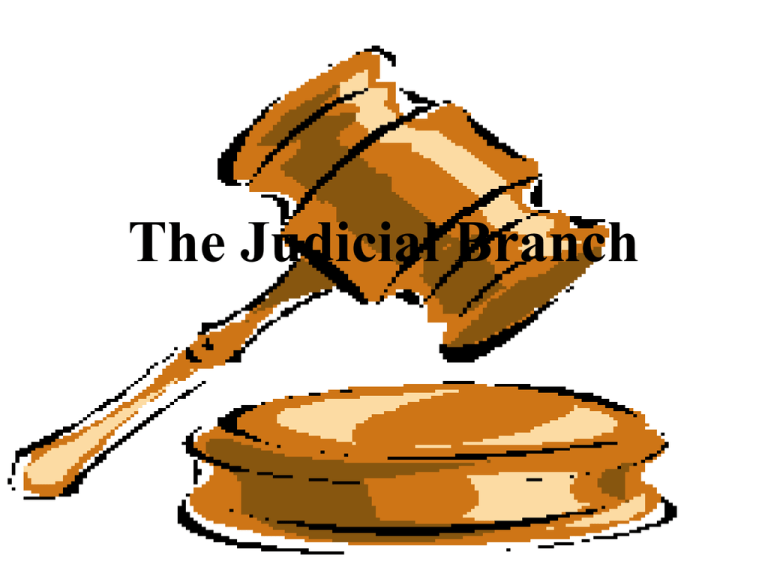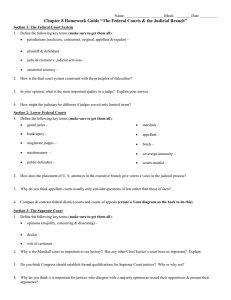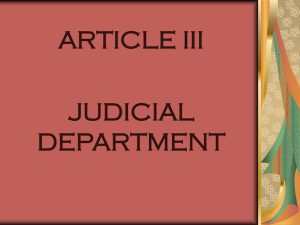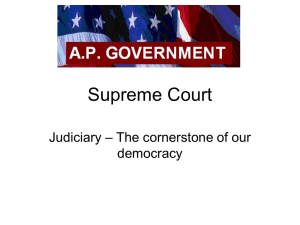The Judicial Branch
advertisement

The Judicial Branch The Constitution and the National Judiciary • Article III of the Constitution establishes: – a Supreme Court in which the judicial power of the United States is vested – life tenure or 'good behaviour' for judges – judges receive compensation that cannot be diminished during their service – such inferior courts as Congress may choose to establish – the original jurisdiction of the Supreme Court • The intent of Article III was to remedy the failings of the Articles of Confederation which left judicial matters to the states. Judicial Review • Judicial review is the power of a court to decide if a law or other legal issue disregards the Constitution, and overturn it. • This power is not mentioned in the Constitution. • Judicial review was established by the Marshall Court in Marbury v. Madison (1803). • Marbury's long-term effect has been to allow the Court to have the final say in what the Constitution means. The American Legal System • The American legal system is a dual system: – state courts--actually 50 different 'systems' – federal courts • Both systems have three tiers: – Trial courts (a.k.a. District Courts): litigation begins and courts hear the facts of the case at hand (original jurisdiction) • One judge, witnesses, presentation of evidence, jury or judge decides the case – Appellate courts (a.k.a. Circuit Courts): decide questions of law, not fact; reviews decisions of lower courts (appellate jurisdiction) • Several judges (3-9), no witnesses (lawyers argue), no evidence presented – Court of Final Appeals: Supreme Courts What “circuit” is Michigan in? Who are Federal Judges? Typically federal judges have: – held previous political office such as prosecutor or state court judge – political experience such as running a campaign – prior judicial experience – traditionally been mostly white males – been lawyers Federal Selection Process President Senators Dept. of Justice ABA Interest Groups Senate Jud. Comm. Senate The U.S. Supreme Court • Highest court in the land • 9 Justices (all but 4 have been white men) – Thurgood Marshall and Clarence Thomas: African American; Sandra Day O’Connor and Ruth Bader Ginsburg: women • Chief Justice: William Rehnquist • Selects about 100 of the over 7000 cases that are submitted to it each year: chooses cases that involve signification Constitutional questions and are important to the entire country Supreme Court Decisions • Majority vote required to determine outcome of case • Write opinions – Majority opinion: states courts decision – Dissenting opinion: states reasons why judge(s) disagreed with majority opinion – Concurring opinion: states reasons why a judge agrees with the decision but for a different reason • Courts do not have the power to implement their decisions. The executive branch must enforce the Court’s decisions. How Supreme Court Decisions are Made Case on the Docket Approx 95 Justices Conference Cases discussed Votes taken Opinion Assigned Briefs and Amicus Briefs submitted Opinions Drafted and Circulated Oral Argument Opinions Announced How the Justices Vote Legal Factors • Judicial Philosophy – Judicial Restraint - advocates minimalist roles for judges – Judicial Activism - feels that judges should use the law to promote justice, equality, and personal liberty. • Precedent – Prior judicial decisions serve as a rule for settling later cases of a similar nature. – Precedents can change over time • Ex. Plessy vs. Ferguson and Brown vs. Board of Education Plessy vs. Ferguson Brown vs. Bd. of Ed. How the Justices Vote Extra-Legal Factors • Behavioral Characteristics – The personal experiences of the justices affect how they vote. Early poverty, job experience, friends and relatives all affect how decisions are made. • Ideology – Ideological beliefs influence justices' voting patterns. • The Attitudinal Model – A justice's attitudes affect voting behavior. • Public Opinion – Justices watch TV, read newspapers, and go to the store like everyone else. They are not insulated from public opinion and are probably swayed by it some of the time. Important Civil and Criminal Law Terminology • Criminal Law – Laws that regulate public conduct and set out duties owed to society – Criminal Case: Court determines whether person accused of breaking law is guilty or innocent – Prosecution (government) vs. defendant – Standard of Proof: Guilt beyond a reasonable doubt (must not have any doubt that defendant committed crime) • Civil Law – Laws that regulate relationship between individuals/groups of individuals – Civil Case: Court settles a disagreement over issues such as contracts, divorce, accidents – Plaintiff (individual bringing complaint) vs. defendant – Standard of Proof: Preponderance of evidence (more likely than not the plaintiff’s version of case is true) Which type of case has a higher standard of proof? Why?








